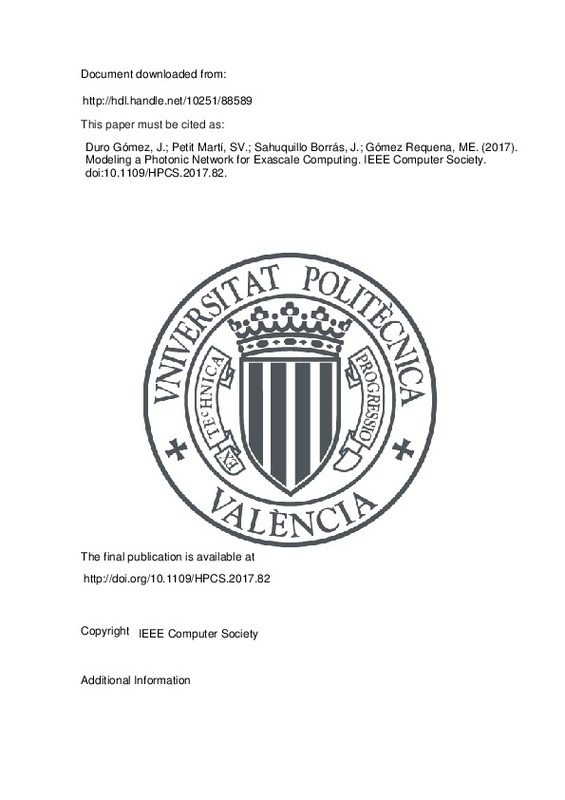JavaScript is disabled for your browser. Some features of this site may not work without it.
Buscar en RiuNet
Listar
Mi cuenta
Estadísticas
Ayuda RiuNet
Admin. UPV
Modeling a Photonic Network for Exascale Computing
Mostrar el registro sencillo del ítem
Ficheros en el ítem
| dc.contributor.author | Duro Gómez, José
|
es_ES |
| dc.contributor.author | Petit Martí, Salvador Vicente
|
es_ES |
| dc.contributor.author | Sahuquillo Borrás, Julio
|
es_ES |
| dc.contributor.author | Gómez Requena, María Engracia
|
es_ES |
| dc.date.accessioned | 2017-10-03T12:41:53Z | |
| dc.date.available | 2017-10-03T12:41:53Z | |
| dc.date.issued | 2017-07-21 | |
| dc.identifier.isbn | 978-1-5386-3250-5 | |
| dc.identifier.uri | http://hdl.handle.net/10251/88589 | |
| dc.description.abstract | Photonics technology has become a promising and viable alternative for both on-chip and off-chip computer networks of future Exascale systems. Nevertheless, this technology is not mature enough yet in this context, so research efforts focusing on photonic networks are still required to achieve realistic suitable network implementations. In this context, system-level photonic network simulators can help to guide designers to assess the multiple design choices. Most current research is done on electrical network simulators, whose components work widely different from photonics components. Moreover, photonics technology adds new components that are not present in electrical networks. This paper discusses how a photonics simulation tool can be built by extending an electrical simulation framework. We summarize and compare the working behavior of both technologies -electrical and photonics, and discuss the rationale behind the proposed extensions. Among others, the devised extensions model optical routers, wavelength-division multiplexing, circuit switching, and specific routing algorithms. This work is aimed to provide support to investigate off- chip optical networks in the context of the European Exascale System Interconnect and Storage project (ExaNeSt) project. The experiments presented in this paper study multiple realistic photonic networks configurations and have been performed with excerpts of real traces. Experimental results show that, compared to electrical networks, optical networks can reduce the execution time of the workload by several orders of magnitude. Our study reveals that future optical technologies presenting a 3.2 Tbps aggregate link bandwidth will not provide additional performance benefits over state-of-the-art 1.6 Tbps optical links across the studied workloads, but 1.6 Tbps network links are enough to achieve the highest optical performance on computer networks. Regarding the link configuration, the bandwidth per optical channel is the parameter with highest impact on the network delay and so on the execution time, while for a given optical bandwidth per channel the better strategy is to reduce the phit size. | es_ES |
| dc.description.sponsorship | This work was supported by the ExaNest project, funded by the European Union’s Horizon 2020 research and innovation programme under grant agreement No 671553, and by the Spanish Ministerio de Economía y Competitividad (MINECO) and Plan E funds under Grant TIN2015-66972-C5-1-R. | es_ES |
| dc.format.extent | 8 | es_ES |
| dc.language | Inglés | es_ES |
| dc.publisher | IEEE Computer Society | es_ES |
| dc.rights | Reserva de todos los derechos | es_ES |
| dc.subject | Fotónica | es_ES |
| dc.subject | Simulación | es_ES |
| dc.subject | Exascale | es_ES |
| dc.subject.classification | ARQUITECTURA Y TECNOLOGIA DE COMPUTADORES | es_ES |
| dc.title | Modeling a Photonic Network for Exascale Computing | es_ES |
| dc.type | Comunicación en congreso | es_ES |
| dc.identifier.doi | 10.1109/HPCS.2017.82 | |
| dc.relation.projectID | info:eu-repo/grantAgreement/MINECO//TIN2015-66972-C5-1-R/ES/TECNICAS PARA LA MEJORA DE LAS PRESTACIONES, COSTE Y CONSUMO DE ENERGIA DE LOS SERVIDORES/ | es_ES |
| dc.relation.projectID | info:eu-repo/grantAgreement/EC/H2020/671553/EU/European Exascale System Interconnect and Storage/ | es_ES |
| dc.rights.accessRights | Abierto | es_ES |
| dc.contributor.affiliation | Universitat Politècnica de València. Departamento de Informática de Sistemas y Computadores - Departament d'Informàtica de Sistemes i Computadors | es_ES |
| dc.description.bibliographicCitation | Duro Gómez, J.; Petit Martí, SV.; Sahuquillo Borrás, J.; Gómez Requena, ME. (2017). Modeling a Photonic Network for Exascale Computing. IEEE Computer Society. https://doi.org/10.1109/HPCS.2017.82 | es_ES |
| dc.description.accrualMethod | S | |
| dc.relation.conferencename | International Conference on High Performance Computing & Simulation (HPCS 2017) | es_ES |
| dc.relation.conferencedate | July 17-21, 2017 | es_ES |
| dc.relation.conferenceplace | Genoa, Italy | es_ES |
| dc.relation.publisherversion | http://doi.org/10.1109/HPCS.2017.82 | es_ES |
| dc.relation.pasarela | S\343306 | |
| dc.contributor.funder | European Commission | es_ES |
| dc.contributor.funder | Ministerio de Economía y Competitividad | es_ES |
| dc.contributor.funder | European Regional Development Fund | es_ES |







![[Cerrado]](/themes/UPV/images/candado.png)

